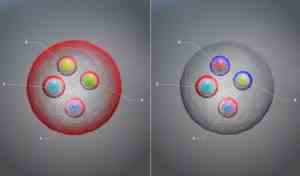Exotic finds: In the particle accelerator LHC, physicists have discovered two new types of particles – and thus expanded the particle zoo to include further exotic variants. On the one hand, it is the first pentaquark that contains one of the rare strange quarks. The second finding is a pair of a doubly charged tetraquark and its neutral counterpart. Both types of particles can help to shed more light on the coupling of such elementary particles.
Quarks are fundamental building blocks of matter, which for a long time were only known as pairs of two or three: protons and neutrons in the atomic nucleus each consist of three quarks, in short-lived mesons a quark and an antiquark form a pair. But in recent years, physicists have discovered new types of particles made up of more than three quarks, including several, in particle accelerators tetraquarks, pentaquarks and even one hexaquark.
Particle Zoo 2.0
“The more analyzes we carry out, the more types of exotic hadrons we find,” says Niels Tuning from the LHCb collaboration at the CERN research center near Geneva. “We are witnessing a period of discovery similar to that of the 1950s, when the particle zoo of hadrons that now form the basis of our Standard Model of particle physics was encountered. Now we are creating the particle zoo 2.0.”
The new particles shed new light on what combinations are possible in the realm of quarks and which processes play a role in this. In 2002, a tetraquark was made for the first time four same quarks proven, in 2021 the first tetraquark followed with double charm(s) consists of two heavy charm quarks and two lighter antiquarks.
First pentaquark with strange quark
Physicists are now reporting on further exotic particle discoveries. They were detected in high-energy proton collisions in the Large Hadron Collider (LHC) at CERN, the most powerful particle accelerator in the world. When analyzing the particle tracks recorded in the LHCb detector, the researchers of the LHCb collaboration came across the signatures of three new particles.
The first find is a pentaquark. The five-quark particle has a mass of 4,338 megaelectronvolts and contains, among other things, two heavy charm quarks. At the same time, it is the first pentaquark with a strange quark – both are types of quark that do not occur in the building blocks of the atomic nucleus. Detection of this exotic particle reached 15 sigma significance, far exceeding the official five sigma threshold for discovery.
Group of five or structure from two subunits?
According to the physicists, the mass of this pentaquark could provide further evidence that in which way the five quarks are connected to each other in such particles. Up to now it has been unclear whether all quarks are equally strongly coupled in such multi-quark particles or whether they are rather loose conglomerates of quark trios and pairs. As early as 2019, a subtle double peak in the particle curves of the LHC provided the first indications of such a structure made up of two subunits.
There is also a lot to be said for the newly discovered pentaquark: “The mass of the pentaquark is on the threshold for baryon meson production,” explain the physicists from the LHCb collaboration. “This could suggest an interpretation as a loosely bound combination of a three-quark baryon and a quark-antiquark meson.”

The first tetraquark pair
The second particle discovery includes a doubly charged tetraquark and its neutral tetraquark partner. It is the first evidence of a paired particle of this type, as the physicists report. Both tetraquarks have a mass of around 2.9 gigaelectronvolts and each consist of a charm quark and a strange antiquark. In addition, one of the partners has an up quark and a down antiquark, the second has a down quark and an up antiquark.
According to the researchers, the particles are probably isospin partners – they represent two states of a quantum mechanical system. However, it is unclear whether there are other partners of this type and how the four quarks are coupled in these particles. This tetraquark pair was detected with a significance of 6.5 and 8 – this is also well above the threshold of an official discovery.
“Finding new exotic particles and measuring their properties will help theorists develop a unified model of these exotic hadrons,” explains LHCb spokesman Chris Parkes from the University of Manchester. “It also helps us to better understand conventional particles such as protons and neutrons.” (International Conference on High Energy Physics, ICHEP 2022)
Source: CERN, University of Manchester

